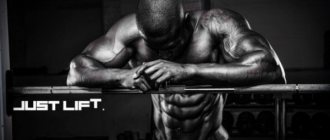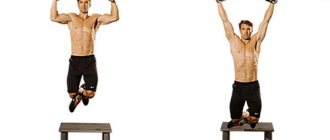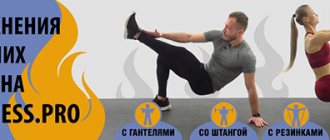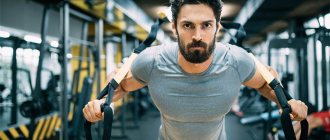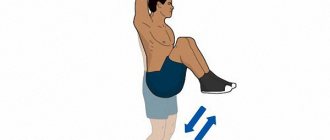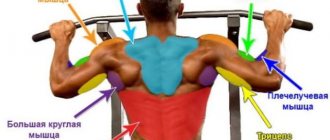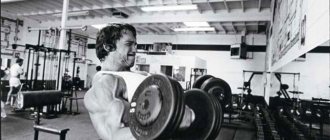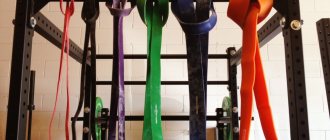To play sports and achieve significant results, you need to make incredible efforts in the fight against laziness and the body.
To have a beautiful and well-developed body, you need to constantly and for a long time train, eat a healthy diet, not have bad habits and maintain the correct daily routine.
All this will allow you to achieve success in sports and make your body beautiful and well-developed. No trip to the gym is complete without doing pull-ups on the bar.
The pull-up is a basic exercise that can be performed by both professional athletes and beginners.
This exercise is aimed at strengthening the muscles of the chest, back and arms. As you might have guessed, today we will talk about pull-ups on the bar.
What muscles are involved?
To understand in detail all the intricacies of working on the bar, first let's delve into the anatomy and find out which muscles work when pulling up on the horizontal bar. This:
- Delta
- Biceps and triceps
- Rhomboid muscle
- The pectoralis major and minor muscles bear the brunt of the load.
- Toothed and anterior
Also, when pulling up, we put stress on the abs, which helps our body to pull up.
How you perform this exercise will determine your endurance and the number of repetitions you can do.
When doing pull-ups, you should always hold your breath, this will significantly increase your endurance. If you do not do this, you may soon feel severe pain behind the sternum.
The initial stage of learning tricks
Learning tricks on the horizontal bar takes time, which depends on the individual abilities of the athlete. Simple movements start with regular pull-ups, after which it is possible to add power exercises with one arm, lifts with inversions and “flags”. These basic exercises may seem uninteresting, but you shouldn't give them up.
By not working out the basic muscle group enough, you can get injured in your arms or spine. Tricks on the horizontal bar for beginners should be performed as follows.
One-arm power output
It is performed at the highest point of the pull-up, then you need to transfer the weight to one of the hands, the elbow of the second rises above the crossbar. It should be lifted and pulled up until both arms are straight.
Checkbox
It looks more impressive, but to do it you should regularly train your abdominal muscles. To perform it, both hands must grasp the side post of the horizontal bar using a multi-sided grip. Having firmly grasped the rack, you can slowly begin to lift your body until it is in a parallel position with respect to the floor.
By the way, the flag can be done not only on the horizontal bar.
Crocodile
Helps in developing a sense of balance . The athlete grabs the bar using a narrow grip, after which the body leans forward and the elbows bend at a narrow angle. You should strive for a perpendicular body position; at first it will be very difficult, but with regular practice it will not be difficult.
These simple exercises help develop endurance and build the muscle mass necessary to perform more complex tricks. You can invite an experienced athlete to continue training. He will not only check the correct execution, telling you how to do tricks without harm to health.
Motivation
Motivation plays a big role in this matter. If you don't find the motivation to exercise, you won't be able to achieve anything.
First, ask yourself the question, why do I need it and what do I ultimately want to get?
After you have answered yourself, begin to tune in to long and exhausting work in the fight against laziness and your body.
During training, constantly encourage yourself, tell yourself that you can do anything. Listen to appropriate motivating music, read the right literature and never give up.
Also, for additional support, invite a friend to study with you, it’s always easier for two people.
Pros and cons of rocking chairs and street workout
There are a number of additional factors that can shift a person’s opinion in one direction or another when we discuss the benefits of bodybuilding or street workout. What are we talking about?
For a powerful workout, comrade!
CHEMISTRY. Where would we be without her? Modern bodybuilding is unthinkable without pharmacology. This factor can often serve as a minus for BB and a plus for street workout. And although it’s not a fact that no one has ever been in the latter... BUT, in general, the goals of workouters are different and therefore there is less pharmacology there.
We recommend Underground 86. Plintovich system
FUNCTIONALITY is a big question. The turnstile man has a lot of opportunities to show his ABILITIES on the street. And a bodybuilder most often has the opportunity to show only his BODY, because in order to show his abilities he needs heavy equipment + an hour of time.
SPECTATORY . Here, too, everything is not clear: who has what? A turnstile man knows how to demonstrate beautiful elements on parallel bars, horizontal bars and other easily accessible street equipment, while a bodybuilder should not show anything, because... everything can be seen from him. Every person wants to have an athletic figure, no matter what they tell you. Bodybuilding is better suited for this, because that’s its point. BUT if the functionality of your muscles is more important to you, then street workout is better because you will have more opportunities to show what you can do.
BIG SPORT . Here are questions for both types. In bodybuilding there are professional tournaments and contracts. Not in street workout. By and large, any professional artistic gymnast can do more than any horizontal bar, and therefore street workout is currently an amateur sport, and bodybuilding is a professional one. On the other hand, is bodybuilding a sport? Where is the fight for meters, seconds, kilograms, for accuracy or balance? By and large, bodybuilding is a strange beauty contest, not a classic sport. That is why, despite the huge number of people involved in it, it is not included in the list of Olympic games. The choice is yours.
COST . In order to engage in bodybuilding, you will need at least a gym membership. And for a better result, you will need to spend a lot more on food, i.e. This is an expensive type of training. If you do street workout, then you don’t need to spend any money at all. For street workout, only your desire is important, so such workouts are ideal for beginners.
I tried to be objective in my assessments of bodybuilding and workout. Sorry if I offended anyone.
The advantage of street workout?
Often a person is fired up with a desire to change himself. Buys an annual gym membership card. And after a month or two he safely gives up this not an easy task. Why? Because the person had no DESIRE. There was no strong motivation. This is the only reason. Everything in nature is in balance. If you want to get something, invest resources (waste energy, nerves, time) to achieve it. Whoever works harder gets more.
We recommend reading the article You Changed about your resources and their proper use.
So, for you to test your motivation for strength, street workout is an ideal choice because you do not waste material resources. At the beginning of any strength training, you will need to train lightly for some time to prepare your body for future strength loads. This is very convenient to do without additional burdens. Those. use exercises without barbells, dumbbells and exercise machines: pull-ups, push-ups, press exercises, etc. In general, do everything that street designers do. Well, in the future, if you see that your “light of desire” does not go out, you can buy a gym membership.
Personally, this is exactly where I started as a child. I went to the horizontal bar every day, did push-ups and trained my abs. Then I bought more dumbbells for home. And only a couple of years later I got into the gym with good motivation and training base. I think if I immediately got into the gym, I would immediately make a lot of typical beginner mistakes that would disappoint me.
Bodybuilding and street workout are very close relatives in strength sports. Both use volumetric resistance training. Many exercises are identical (pull-ups and dips are classics of the genre in both cases).
Horizontal bar athletes use a higher repetition range than bodybuilders, which leads to specific training skills.
Bodybuilders are more massive due to the size of their muscles, which irritates many ordinary people who are trying to find all the deadly sins of jocks. Horizontal bar athletes are capable of performing a number of technically complex and spectacular exercises that bodybuilders cannot master.
Horizontal bar runners engage in an activity more like a sport (who will do more repetitions, who can do a more complex element) BUT this activity is unlikely to ever be appreciated and become a professional sport, because in these niches there are already artistic gymnastics and acrobatics. Bodybuilding has all the attributes of a professional sport now, but most even experienced athletes are neither cold nor hot because the sport has not become an Olympic sport (and I don’t think it will), and only Americans grab contracts and money.
We recommend 199. Gods of aesthetics. Zyzz (Aziz Sergeevich Shavershyan)
What else did I forget?
Oh yes. I have already said many times that the main problem of most gym goers is that they do FITNESS, but think about BODYBUILDING. Fitness is training with light weights, with minimal progression (or no load at all) for health benefits. Bodybuilding is already a SPORT. And any athletic sport is harmful to health because it requires “working on the edge” of opportunities to win. Bodybuilding is a serious stress load, it's a progression of weights, it's chemistry.
In general, strength training can be divided into amateur and professional. If we do this, we will get FITNESS and BODYBUILDING. Street workout seems to me to be a wonderful type of FITNESS training, because there is no systematic overload, chemicals and other “joys” of professional sports. Maybe this is the main advantage of street workout?
Negative repetitions
A technique proven over the years that will be useful for beginning athletes.
Its essence is to secure yourself on the bar as if you had already pulled yourself up and hang for the maximum amount of time.
This technique allows you to strengthen your muscles at the initial stage and add confidence in further training.
Sample training plan
The useful horizontal bar exercises presented below will help you create your own program based on your level.
Advice: in order to create a training program for yourself on the horizontal bar, you can search the Internet for photos or videos of exercises in order to better understand the technique.
Those who are just starting to exercise their body should choose 2-3 exercises from the first block and do the maximum number of repetitions and approaches to develop strength and endurance. Let's add one exercise for the core muscles and grip strength - that's a complex for a beginning athlete.
Experienced people should train in the second most difficult part of the elements, and also do a set of abdominal exercises on the horizontal bar and develop the correct grip. Three different grip styles, finger exercises and core exercises at the end are the basis of your workout.
Those who have been practicing on horizontal bars for a very long time should start by practicing the selected element, then train endurance in any type of pull-ups, and finish the workout with exercises for the abs and grip tenacity.
Important: be sure to warm up before training. For beginners, regular joint gymnastics will suffice, while higher-level athletes should warm up with the same low-intensity pull-ups.
Popular errors and problems
Unfortunately, we cannot always achieve results, even when we put in a huge amount of effort. This could be due to several factors such as:
Improper execution of the exercise. You can eat right, exercise every day, work until you lose strength, but if you do the exercises incorrectly, then nothing will help you. It is very important to follow the correct technique and do everything slowly.
Being overweight is a popular problem for many people who want to exercise.
Such a person works out for a long time and diligently, but does not show results, he does not know how to increase the number of pull-ups on the horizontal bar, because everything is frozen in one place.
In this case, you need to lose excess weight, about 7-10 kilograms, and then start exercising again.
Don’t focus your attention on just one exercise, constantly pump up all muscle groups and only then will you see results.
Always warm up your muscles before starting pull-ups. Do a short 5-minute warm-up, this will significantly reduce the likelihood of injuries and sprains.
There is no need to work to failure in the first week, exhausting the body with loads, everything should happen gradually.
It is interesting to know that the world record for pull-ups on the horizontal bar was set by a 70-year-old man from South Korea in 1994. He was able to do 630 pull-ups. To date, no one has been able to surpass this record.
We advise you to keep your personal diary of results, in which you will record your personal record for pull-ups on the horizontal bar in one approach. This will allow you to see your results and give you motivation for further training.
How to train on the horizontal bar and parallel bars
It is best to train three times a week, giving your muscles rest. Typically, pull-ups, dips, and muscle-ups are separated and done on different days. However, nothing prevents you, with the proper level of training, from pumping your entire body in one workout and even training every day.
Below you can see a simple and fairly common program designed to develop target muscles and increase strength.
An extremely important and mandatory element of our training is warm-up. Any five-minute complex will warm up your joints and ligaments and set them up for work. Usually the pre-workout complex is performed “from top to bottom”, that is, first we will deal with the neck, and then it will come to the hips and ankles. So:
Warm-up
Neck. We press our chin to our chest and remain in this position for one or two seconds.
- We stretch our trapezius: to do this, you need to carefully grab your head and lower it down to your shoulder. Do this a couple of times in each direction, then rotate your neck a little.
- Warm up your pectoral muscles well: clasp your hands and pull them back, then lift them up.
- Back. Grab a support and lean back, straightening your legs - you should feel a stretch in your lats.
- Everyone knows exercises for the oblique abdominal muscles - these are the usual bending of the torso to the side.
- It’s more difficult with the triceps: we place the bent arm behind the head, place it slightly lower than the neck, and with the other hand we pull the elbow. Repeat in mirror for the other hand.
- Rotate your shoulders, knead them well.
- For your legs, you need to lunge forward and to the side, and also be sure to stretch your knee joints. Place your feet shoulder-width apart, shift your body weight to one side, squatting on your leg. Then stand up and repeat the movement in the other direction. Place your feet together, place your hands on your knees and rotate them - this will stretch your knee joints.
Training program
Let's look at the training program on the horizontal bar and uneven bars using the example of a 3-day training. By dividing the exercises into these groups, it is easier to distribute the load and ensure muscle recovery, and therefore growth. Day 1
- Wide grip pull-ups. In these exercises, it is better to try to perform the maximum number of repetitions in each approach. Try, for example, doing it 70 times per workout - this will be an excellent test for your muscles.
- Hanging leg raises are a great abdominal exercise, but they do put a lot of work on your forearms. So try to do 4 sets of 10-15 reps. At first, simply raise your knees to your chest. As you get stronger, you will move on to straight leg raises 90 degrees, and then to touching the top of the bar with your feet. A variety of abdominal exercises on the horizontal bar are described in the article.
- To finally finish off your back and arms, take the time to master one-arm pull-ups. This is a very advanced movement, but the sooner you start trying, the faster you will learn.
Day 2
- Triceps or chest style dips. Try to do the maximum number of times in four approaches.
- Raising legs with support on parallel bars. We get into the position for regular push-ups and try to make a “corner”, that is, holding straight legs at an angle of 90 degrees.
- Exercise for muscular endurance: we do push-ups, but after each repetition we move our hands closer to the end of the exercise. The task is to overcome the entire length of the bars and return to the starting point.
Day 3
- Reverse-grip pull-ups, or if you're strong enough, try learning how to power-up—this exercise will help develop your upper chest.
- This day is best spent studying various strength elements, such as lifting coups and muscle-ups.
On any day of training, it is important to follow a diet and correctly create a nutrition menu to build muscle mass. And then excellent results will not keep you waiting. If regular pull-ups and dips are too easy for you, hang additional weight on your belt or use a backpack, this will give a new impetus to muscle growth
If regular pull-ups and dips are too easy for you, hang extra weight on your belt or use a backpack, this will give a new impetus to muscle growth.
Don't forget about your feet. Be sure to set aside a day in which you will do squats, jumping jacks, and calf raises.
And most importantly, train hard and don’t skip classes, because only then will you be able to achieve the results you need.
How to do pull-ups correctly?
Proper pull-ups are not only about performing this exercise, but also about the number of repetitions performed.
For this, there is a special pull-up pattern on the horizontal bar. You can find it in any thematic Internet source and familiarize yourself with it in detail.
So in the first week you need to do at least 120 pull-ups. Every day, 3 sets of 15 pull-ups. This technique will help strengthen your muscles and prepare them for even greater loads.
Rules for training
There is no need to overdo it and perform too many approaches. To avoid harm to health, increase the level of stress gradually.
Fitness classes using a horizontal bar will be highly effective if you strictly follow the following several rules:
- The body of the body should be positioned perpendicular to the floor, and the grip of the horizontal bar should be as strong as possible;
- Pull-ups should be carried out only using muscle strength and without unnecessary swinging;
- The ascents are smooth, there are no jerks;
- The lift must be done until the chin is above the level of the crossbar;
- Lower your body slowly and smoothly. This stage should be as long as the time spent lifting the body up;
- Breathing mode: exhale on the way up, inhale on the way down.
The fact that you are pulling yourself up correctly with a narrow grip should be signaled by touching the bar with your lower chest. When performing exercises with a wide grip, do not bend too much or make jerky movements. A reverse grip involves straightening your shoulders and squeezing your shoulder blades together.
An individual fitness plan for training on the horizontal bar can be wisely diluted with additional loads that are designed to stimulate growth. For this purpose, you need to hang freely, while holding onto the bar, and perform swings and turns in different directions. The torso will stretch under the pressure of its mass.
Beginning athletes must first master at least two types of pull-ups. You need to do it without haste and taking into account professional recommendations.
Types of pull-ups
Let's look at what types of pull-ups there are:
- Supinated pull-up. It is performed with weights, the biceps is on the outside.
- Mixed pull-up. Every other time you change your hand grip.
- Using a rope. This exercise can only be done by experienced athletes. The main difficulty is that your hands will constantly slip, and the rope will sag in different directions.
Develop for yourself a table of pull-ups on the horizontal bar and write down in it which days you will perform this or that type of pull-up, this will help you build muscle mass faster.
Exercises on the horizontal bar for beginners
There are basic exercises that are recommended for performing on the horizontal bar at home or in the gym. They are practically no different for beginners and professionals, only in the applied load.
An approximate exercise program for beginner athletes or those who want to stay in shape will consist of pull-ups:
- negative. They are carried out using a stand located under the horizontal bar. The exercise consists of alternately lifting and lowering from the stand, holding the horizontal bar with a reverse grip;
- jumping. Standing under the simulator, you should make a small jump, grabbing the bar. Gradually, with the help of your hands, you need to take the starting position. The condition for achieving the result will be full extension of the arms using muscle load;
- using rubber. This exercise involves using a special shock absorber located on the crossbar. You need to rest your feet on it so that the man can help himself when pulling himself up.
As you gain experience, training should be carried out without the use of additional means, which will help you get in good shape. This includes pull-ups with narrow, wide, reverse, and different grips.
What muscle groups are involved in the work?
When performing a complex on the crossbar, many muscles are involved in the work, which makes this type of training very effective. Performing pull-ups or other exercises on the horizontal bar forces the following muscle groups to work:
- deltoid;
- diamond-shaped;
- serrated, trapezoidal;
- round muscles of the back;
- shoulder girdle;
- forearms;
- biceps and triceps;
- pectoral muscles.
Exercises for the abs
Exercises on the bar can be done to strengthen the abdominal muscles. This will simultaneously improve not only the specified muscle group, but will also lead to a general strengthening of the entire upper half of the body.
The only type of exercise for the press is raising the legs while hanging on the bar above the level of the hips. In this case, there is a different load distribution. If the exercise occurs with the legs bent at the knees, then the lower and middle abdominal muscles receive a greater load. If the legs are straight, then the overall load increases significantly. The highest point of this complex is lifting the legs to the crossbar.
Biceps exercises
The main goal of most athletes who use the bar as a trainer is to strengthen their arm muscles. Biceps exercises involve doing pull-ups with a reverse grip. This means that the hands should be turned with the palms facing the man's face.
Pumping the biceps on the horizontal bar also loads the muscles in different ways. At the beginning of bending, a large load falls on the lower and middle parts of the muscle, and at the very end the upper sections work. When the arm is extended, tension occurs in the triceps. This exercise helps to achieve harmony in working out the relief of the arms.
Back exercises
Exercises for the back also involve doing pull-ups. The only difference is in the grip. To fully engage the latissimus muscles and other groups of spinal muscles, you need to use a wide grip. At the same time, during the pull-up process, the crossbar should remain behind the man’s head. This complex affects the round muscles, which give volume to the back. Regularly performing exercises on the horizontal bar for your back will not only help make it wider, but will also give it relief.
Complex exercises on the horizontal bar and parallel bars
The second most accessible exercise machine, which does not require a visit to the gym, but allows you to get sufficient load on a large number of different muscle groups, is the parallel bars.
A combination of crossbar and bars can give a good result. A set of such exercises includes alternately performing approaches, first on one, then on another apparatus.
A good workout would include pull-ups performed over several sets. Next, you can move on to the uneven bars, where you should perform push-ups. It is also recommended to perform them in several approaches.
The second group of exercises is pumping the press. How to do this on the crossbar was discussed above. On parallel bars, you need to lift your legs at a right angle, trying to do it as many times as possible. In this case there can be only two approaches.
Risks of injury
Playing sports does not guarantee your complete safety; there is always a risk of injury. To prevent this you need to follow certain rules.
Always pay attention to the condition of your palms. The appearance of calluses is a signal to stop pulling up for a while.
Give your body time to rest and recover. To make it more comfortable for you to practice, use gloves.
Never make sudden jerks, otherwise you risk straining muscles and breaking bones.
To avoid pain during pull-ups, you need to warm up your muscles.
Do a short 5-minute warm-up to warm up your muscles and minimize the risk of injury.
Rest mode during push-ups on the horizontal bar
It is worth noting that grips allow you to work on different muscle groups. You must understand that the training program on the horizontal bar must be strictly followed, only in this case you will be able to achieve maximum results. It is worth understanding that a narrow grip is considered to be the best option.
This is a technique that will allow you to achieve the desired results in a short time. This technique allows you to work out the pectoral muscles and arm muscles well. If you want to achieve noticeable results, then you should pay attention to nutrition. Pull-ups on the horizontal bar photo program, before and after you can see the progress. If we talk about nutrition, we recommend that you focus on protein foods. This is a great foundation for your muscles.
Rest mode
You also need to understand that regular training is of great importance. Don't forget about rest. If you do everything right, then in the near future you will be able to show off a beautiful body. If you find it difficult to adapt to the horizontal bar, then it is better to give preference to a narrow grip. This is the simplest pull-up technique. Start practicing today and in a few weeks you will be able to see the first results. You must understand that a beautiful body means health and a healthy lifestyle. Make a training schedule for yourself, this will make it easier for you to stick to the regime. Don't forget about good nutrition.
Where to buy equipment?
If you don’t have enough time to visit the gym or go to the playground, then you can always start exercising at home.
For this you need special equipment. Then the question immediately arises, where to buy a pull-up bar?
Luckily, you shouldn't have any problems with this. The horizontal bar and all its components can be purchased at any sports store. The average price for a wall-mounted horizontal bar will start from 2000 to 3500 thousand rubles. Play sports, train your body and be healthy!
Step-by-step instructions on how to learn to do pull-ups from scratch
In order to learn how to do pull-ups from scratch, you need to perform a series of preparatory exercises that will prepare your body for the load. By regularly practicing these exercises, you will be able to master pull-ups on the bar, even if you have never done them before and even if you do not believe in your strength. These exercises are suitable for both men and women, the degree of load is regulated independently. Strengthening exercises will help you strengthen not only your muscles, but also your ligaments and joints.
Thanks to YouTube channels for the gifs: OfficialBarstarzz, Abnormal_Beings, Colin DeWaay, Xenios Charalambous, Matt Cama 2.
1. Exercises with additional weight for muscles
Exercises with additional weight will help you strengthen the latissimus dorsi and biceps muscles, which are involved in pull-ups. You can use dumbbells instead of a barbell. Perform each exercise in 3-4 sets, 8-10 repetitions. Rest 30-60 seconds between sets. Choose a weight such that the last exercises in the set are performed at maximum effort.
Bent-over barbell row:
Bent-over dumbbell row:
Vertical pull of the block:
Horizontal pull of the block to the belt:
If you do not have access to machines and free weights, then to prepare for pull-ups, you can immediately begin the exercises on the horizontal bar, which are presented below.
2. Australian pull-ups
The Australian Pull-Up is the perfect exercise to help you learn how to do a Pull-Up from scratch. To perform it, you will need a low bar, approximately at waist level (in the gym, you can use the bar on a Smith machine). Please note that during the Australian pull-up, your body should remain straight from your heels to your shoulders. You cannot bend down or bend up; the whole body is tense and taut.
The most important advantage of the Australian pull-up is that absolutely everyone can do it, since its difficulty is determined by the angle of inclination. The more vertical your body is, the easier it is to perform the exercise. Conversely, the more horizontal the body is, the more difficult it will be to perform the Australian pull-up. The load also depends on the height of the crossbar - the lower it is, the more difficult it is to pull yourself up.
When performing Australian pull-ups, we recommend changing your grips: wide grip, shoulder-width grip, narrow grip. This will allow you to effectively work all muscle groups from different angles and adapt to pull-ups. You can perform 15-20 repetitions with different types of grips.
3. Pull-ups with loops
If you do not have a bar for performing Australian pull-ups or you want to better prepare for classic pull-ups on the horizontal bar, then you can do pull-ups with loops. The gym usually always has such devices, but at home there is also a good alternative - TRX loops. This is a very popular exercise machine for exercising with your own body weight and developing all muscle groups. With TRX you can learn to do pull-ups even faster.
TRX loops: what are they + exercises + where to buy
4. Leg-supported pull-ups
Another lead-up exercise is pull-ups on a low bar with your feet resting on the floor. To practice this exercise, it is not necessary to have a low bar; you can place a box or chair under a regular horizontal bar and rest your feet completely on it. This is much simpler than regular pull-ups, but is ideal for muscle training.
5. Chair pull-ups
A slightly more complex version of the previous exercise is a pull-up with one leg resting on a chair. At first, you can completely rest one leg on the chair, but gradually try to support your weight with the muscles of your arms and back, leaning less and less on the chair.
6. Hanging on the horizontal bar
Another simple but very effective exercise that will help you learn how to do pull-ups from scratch is hanging from a horizontal bar. If you cannot hang on the horizontal bar for at least 2-3 minutes, then it will be difficult for you to pull yourself up. Hanging on a horizontal bar is useful for strengthening your wrists, developing your back muscles, and straightening your spine. This exercise will also help your ligaments get used to the weight of your body.
Please note that when hanging on the horizontal bar, your shoulders should be down, your neck should be extended and not pressed into your shoulders. The body should remain free, the spine elongated, the stomach tucked. You can perform the exercise in several approaches for 1-2 minutes.
7. Pull-ups with rubber loops
If you calmly hang on the horizontal bar for several minutes, then you can move on to the next stage - pull-ups with rubber loops (expander). One end of the rubber band is attached to the crossbar, and the other secures the leg. The expander will take on some of your weight and pull your body up. Rubber loops can be purchased on Aliexpress; details with links to the product are in the second part of the article. By the way, this type of expander is suitable not only for pull-ups, but also for many strength exercises.
8. Jumping pull-ups
Another basic exercise that will help you learn how to do pull-ups from scratch is the jumping pull-up. If you've never done a pull-up before, you may not be able to do it, so it's best to start by practicing the exercises presented above. If your muscle strength allows you to perform a jumping pull-up, then this exercise will perfectly prepare you for regular pull-ups.
Its essence is as follows: you jump as high as possible to the horizontal bar, hold yourself for a few seconds and slowly lower down. This can be said to be one of the options for negative pull-ups.
9. Negative pull-ups
Any exercise has two phases: positive (when the muscles tense) and negative (when the muscles relax). If you cannot yet withstand both phases of a pull-up (that is, pull yourself up on the horizontal bar and lower yourself down), then perform only the second phase of the exercise or the so-called negative pull-up.
For a negative pull-up, you need to hold the position with your arms bent over the bar (as if you had already done a pull-up), using a chair or the help of a partner. Your task is to stay at the top as long as possible and then very slowly lower down, tensing the muscles of your arms and back as much as possible. The negative pull-up is another great exercise to help you learn how to do a pull-up from scratch.
The number of repetitions in the last three exercises depends on your capabilities. At first, you will probably do only 3-5 repetitions in 2 sets. But with each lesson you need to increase your results. Aim for the following numbers: 10-15 repetitions, 3-4 sets. Rest 2-3 minutes between sets.
Pull-up training diagram for beginners
We offer you a ready-made diagram of how to learn how to do pull-ups from scratch for men and women. The scheme is universal and suitable for all beginners, but you can adapt it to your capabilities by slightly lengthening or shortening the plan. Train 2-3 times a week. Before doing pull-ups, be sure to warm up and at the end, stretch the muscles of your back, arms, and chest:
- Ready pre-workout warm-up
- Post-workout stretching routine
Ideally, start training with back exercises (barbell rows, vertical and horizontal rows), but if this is not possible, you can only train on the horizontal bar. If you are faced with the task of learning how to do pull-ups on a horizontal bar from scratch in a short time, then you can practice 5 times a week. But not more often, otherwise the muscles will not have time to recover and there will be no progress.
The plan below is designed for beginners. If you are already a fairly experienced practitioner, then feel free to start with 3-4 weeks. The diagram indicates only the approximate number of repetitions; it is always better to focus on your physical capabilities. Be sure to record how many reps and sets you did to track your progress. You can rest for 2-3 minutes between sets or dilute the pull-ups with other exercises.
First week:
- Leg-supported pull-ups: 5-8 reps 3-4 sets
Second week:
- Leg-supported pull-ups: 10-15 reps 3-4 sets
- Hanging on the horizontal bar: 30-60 seconds in 2 sets
Third week:
- Australian pull-ups: 5-8 reps 3-4 sets
- Hanging on the horizontal bar: 45-90 seconds in 3 sets
Fourth week:
- Australian pull-ups: 10-15 reps 3-4 sets
- Hanging on the horizontal bar: 90-120 seconds in 3 sets
Fifth week:
- Chair pull-ups (supporting one leg): 3-5 reps in 2-3 sets
- Australian pull-ups: 10-15 reps 3-4 sets
- Hanging on the horizontal bar: 90-120 seconds in 3 sets
Sixth week:
- Pull-ups with rubber loops: 3-5 reps in 2-3 sets
- Chair pull-ups (leaning on one leg): 5-7 reps in 2-3 sets
Seventh week:
- Pull-ups with rubber loops: 5-7 reps in 2-3 sets
- Chair pull-ups (leaning on one leg): 5-7 reps in 2-3 sets
Eighth week:
- Negative pull-ups: 3-5 reps in 2-3 sets
- Pull-ups with rubber loops: 7-10 reps in 2-3 sets
Ninth week
- Jumping pull-ups: 3-5 reps in 2-3 sets
- Pull-ups with rubber loops: 7-10 reps in 2-3 sets
Tenth week
- Classic pull-up: 2-3 reps in 2-3 sets
- Jumping pull-ups: 3-5 reps in 2-3 sets
You can speed up your training plan if you are experiencing more progress than what is indicated in the plan. Or vice versa, slow down the pace of increasing the number of repetitions if you are not yet able to achieve the desired result. Don't worry, sooner or later you will be able to achieve your goal!


